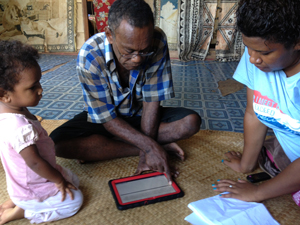Matthias Helferich
How mobile survey technology still works in spite of difficult infrastructure
Comprehensive internet access, reliable mobile communications networks and a secure electricity supply – we only learn to truly appreciate these achievements of our age when they are gone; both in our private lives and even more so in our occupations. But in the field of ecological research and climatology, research teams often have to endure such adversity – field work often takes place in poorly developed regions that are difficult to access.
From February to March this year, the research institute Landcare Research in New Zealand carried out a study on the effects of climate change on Fiji, together with the Institute of Applied Science of the University of the South Pacific. This study was designed to understand the impact of natural disasters on the life of the population. In the past, the inhabitants of the archipelago suffered particularly frequent severe natural disasters such as storm tides, floods and storms. Combined with geographic data (GIS), the researchers now want to use the survey to help create risk profiles for Fiji and in doing so, better assess the risk of future catastrophes.
But what can we, as people spoiled by technology, do to research the effects of climate change in regions where the technological infrastructure is anything but reliable? Landcare Research had this very problem. Fiji is situated around 2,100 kilometres north of New Zealand. The archipelago consists of 332 islands, of which 110 are inhabited. Most of the population on Fiji lives in the city regions, but some people do also live in remote villages.
 Due to the lack of internet access, mobile communications networks and a secure electricity supply in wide regions of Fiji, they faced the question of whether to carry out a very complex study using either traditional means or modern technology. Both methods had their risks. It was necessary to find a largely self-sufficient technology that did not depend on the internet and that would allow for a highly complex survey which would not have been feasible with traditional pen-and-paper. In the end they opted for German technology to implement the project, using mobile survey software mQuest, and Samsung tablets with Android operating systems. It was a decisive advantage that the survey could be carried out fully independent of an internet connection. All information, interviews and images collected had to be saved on the tablets and transferred to the institute’s server at the end of the field work. From this point on, the collected results were available for final analysis.
Due to the lack of internet access, mobile communications networks and a secure electricity supply in wide regions of Fiji, they faced the question of whether to carry out a very complex study using either traditional means or modern technology. Both methods had their risks. It was necessary to find a largely self-sufficient technology that did not depend on the internet and that would allow for a highly complex survey which would not have been feasible with traditional pen-and-paper. In the end they opted for German technology to implement the project, using mobile survey software mQuest, and Samsung tablets with Android operating systems. It was a decisive advantage that the survey could be carried out fully independent of an internet connection. All information, interviews and images collected had to be saved on the tablets and transferred to the institute’s server at the end of the field work. From this point on, the collected results were available for final analysis.
Providing electricity for the tablets was tricky. It was necessary to plan the resources and procedures precisely, in order to avoid running the risk of going dark in the middle of the survey and losing valuable survey time and resources. In the accommodation during the evenings, the top priority was to charge up the batteries. ‘This type of project requires precise planning’, says Pike Brown, Senior Economist at Landcare Research, ‘and it is extremely important that you can rely on your tools 100 per cent. Fortunately, at least there was no risk of losing the data since the software would have stored it even if the batteries did run dry.’
2,500 possible data points overtaxing the clipboard
Most socioeconomic studies are extremely complicated and consist of question concepts with highly complex logic and validation. Even in this regard the project proved a challenge for the researchers: the questionnaire, consisting of a total of 15 different forms, was comprised of 2,500 individual data points. The study was to cover 400 households, many of which were situated in particularly remote villages. A large number of conditional questions also meant that jumping backwards and forwards in the survey was inevitable. This would simply not have been possible for a surveyor with pen-and-paper and this number of questions – the high probability of error notwithstanding. The logic programmed in advance ensured an efficient ‘flow’ through the questionnaire. Integrated plausibility checks ensured a high level of data quality and fewer input errors.
The majority of the project workers were doing this work for the first time, but nevertheless the training process proved very simple. The interviewers were greatly impressed by the easy portability of the questionnaire during field work, ‘The unanimous feedback from the field was exceedingly positive. We used the paper forms to train all of our workers at the start. They were all delighted about the switch to the tablets and could appreciate how much easier their work had become thanks to the software-assisted questionnaire’, explains Brown.
He also saw the quick availability of data and user-friendly questionnaire corrections as advantages of the software- and tablet-assisted survey method: ‘There is now absolutely no time-consuming data input at the end of the study and this represents a significant improvement over the traditional method. We also particularly liked the fact that we could change and correct questions on the move without having to fully redesign and print the questionnaire.’
 Success for the future and improved data quality
Success for the future and improved data quality
‘This was a pilot project for us and we are very happy with the solution. However, thanks to our experience we also know that future projects will offer even more potential savings in terms of time and money. Programming the comprehensive and complex questionnaire in the initial project stages was very time-consuming, but we were able to save a third of the time by filling out the questionnaire faster.’
Landcare Research considers the improved data quality to be the greatest advantage: ‘I estimate that the number of input errors has fallen by at least 50 per cent’, says Brown. ‘Also, since we had the data to hand at the end of each day, we were able to make corrections on site.’ Overall, this allowed 80 per cent of errors to be corrected during the field work.
No return to pen-and-paper
For the future, Landcare Research plans to continue expanding the use of mobile survey technology and to use it to carry out more projects. ‘The comfort of the technology completely won us over and a return to pencil and paper simply no longer makes sense. By now, we have already become so used to the advantages that we won’t do without it’, concludes Brown.
Eight practical steps for researchers who want to manage mobile research projects in areas with little infrastructure.
- Check general surrounding conditions: How is the technical infrastructure in the area/country you want to execute the research project: WiFi availability, mobile communications network, electricity supply?
- Verify extent and complexity of the survey: Define how many people you want to interview and consider the complexity of the questionnaire! How many interviewers will be necessary to conduct the interviews in the given time? Also consider logistical challenges as e.g. islands being difficult to reach..!
- Evaluate if you want to carry out the project via paper & pencil or with aid of mobile CAPI: If you plan to do similar research projects in the future, investments in the technical equipment and the time to get familiar with the software will be more profitable. Check if you can use standard tools to execute the project. Compare both methods and calculate the pros and cons.
- Decide for appropriate technical devices: Think about the technical support your project needs and define what requirements the mobile devices have to fulfil. What device will be most suitable (smartphone, big or small tablet, ..) according to the usability of the questionnaire? Also consider the battery run-time of the different devices! Take replacement batteries or devices with you!
- Make sure that the software complies with your needs: To be able to verify if the chosen software is the right one, your questionnaire template including logics should be as final as possible. Can the software e.g. easily handle different and exotic languages, photos, complex calculations, GPS or plausibility checks? Consider that highly complex questionnaires need time to implement!
- Test your equipment and simulate the whole set-up: Before going in the field, test the whole project set-up thoroughly! Plan a couple of days to go through the questionnaire and check all functions (usability, data entry, data synchronisation, evaluation).
- Train your interviewers on the questionnaire and device: To make sure that all interviewers can properly handle their tools, train them sufficiently! Show them how the questionnaire has to be filled out and how the hardware works.
- Be prepared for technical problems in the field and offer help: In remote areas, the interviewers have to solve occurring problems on their own. In case of technical problems with the equipment during the field work, you should offer the researchers a brief operating manual or FAQs installed on the tablet or Smartphone.
Matthias Helferich, Managing Director of cluetec GmbH, Germany


